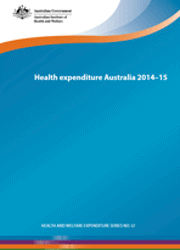Summary
This report provides the latest annual overview of the key trends in health expenditure in Australia. It represents 32 years of the AIHW's health expenditure series, and examines health expenditure according to who paid (the source of funds) and the types of health goods and services purchased (area of expenditure) between 2004–05 and 2014–15.
Growth in health expenditure in Australia continued to be relatively low in 2014–15 compared with the 10-year trend. But this was not the case for all sources of funds and it did not result in a reduction in the ratio of health to gross domestic product (GDP), or the ratio of government health expenditure to tax revenue, reflecting even slower growth in those measures.
Total health expenditure
Total health expenditure (recurrent and capital expenditure combined) in 2014–15 was $161.6 billion—$4.4 billion (2.8%) higher in real terms than in 2013–14. This was the third consecutive year that growth in health expenditure was below the 10-year average (4.6% between 2004-05 and 2014-15).
Growth in health expenditure per Australian ($6,846 in 2014–15) was also relatively low, at less than half the average annual growth over the decade (1.4% compared with 2.9%).
Despite the low growth, the share of the economy (GDP) that health represented reached 10.0% for the first time. Using OECD definitions, Australia's health to GDP ratio (at 9.7%) was above the OECD median (9.1%) by the largest amount since 2004 (0.6 percentage points).
Government expenditure
Total government health expenditure ($108.2 billion) grew by 1.3% in 2014–15—less than one-third the average rate for the decade (4.3%). The ratio of government health expenditure to tax revenue remained relatively stable over the 3 years to 2014–15. From 24.6% in 2012–13 and 2013–14, it rose by 0.2 percentage points in 2014–15 to 24.8%.
Real growth in Australian Government expenditure was 2.4% in 2014–15 compared with an average over the decade of 4.0%. The ratio of Australian Government health expenditure to taxation revenue grew by 1.4 percentage points (from 25.0% in 2013–14 to 26.4% in 2014–15).
State and territory expenditure declined in real terms for the first time in the decade (by 0.4% compared with average annual growth of 4.8% per year).
Combined with relatively strong growth in state and territory tax revenue in 2014–15 (7.9% compared with an average annual growth of 5.6%), this meant the ratio of health expenditure to tax revenue for state and territory governments fell by 1.4 percentage points (from 24.0% in 2013–14 to 22.6% in 2014–15). This is the third consecutive year this ratio has declined, and it occurred in all states and territories, although the amount varied.
Non-government expenditure
Non-government sources (individuals, private health insurance and other non-government sources) spent $53.4 billion on health in 2014–15 (33.1% of total health spending, up from 32.2% the previous year). Growth in non-government expenditure in 2014–15 was higher than for government (5.9%), and above the average annual growth over the decade (5.4%).
Preliminary materials: Acknowledgments; Abbreviations; Symbols
1 Introduction
- What is health expenditure?
- The structure of the health sector and its flow of funds
- Structure of this report
- Changes to Australian Institute of Health and Welfare estimates
- Revisions to Australian Bureau of Statistics estimates
2 Health expenditure
- Health expenditure and the GDP
- Government health expenditure and tax revenue
- Health expenditure per person
- Recurrent health expenditure
- International comparisons
3 Sources of funds
- Broad trends
- Capital expenditure
- Australian Government expenditure
- State and territory expenditure
- Non-government expenditure
- Individuals
Appendixes:
Appendix A: National health expenditure matrixes
Appendix B: State and territory health expenditure matrixes
Appendix C: Data sources and methods
Appendix D: Data quality statement for AIHW health expenditure data—2014–15 release
End matter: Glossary; References; List of tables; List of figures; List of boxes; Related publications



